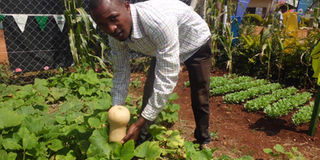How to ensure bumper harvest from butternut

An agronomist at Jinja Agriculture show explains how the plant is grown. Photo by Lominda Afedraru
What you need to know:
- The plant grows well in warm weather but it can withstand cooler conditions better than other cucurbit plants such as pumpkins, cucumber or melon, writes Lominda Afedraru.
Butternut squash is a vine crop of the cucurbit family. This tropical crop is an alternative choice four pumpkin lovers.
This is because the butternut squash fruits locally known as ‘ensusuuti’ not only looks like a tiny pumpkin but it tastes alike.
Locally we do not have a specific name for the cucurbit as it is kind of an exotic plant.
It is rich in beta-carotene containing Vitamin B2, C and A thereby improving the body immunity and cancer patients are advised to consume it.
As such, stakeholders engaged in the agricultural value chain are advising Ugandan farmers to grow butternut alongside pumpkins because it produces a lot of the nuts.
Seed companies in Uganda have taken on multiplying the seed of butternut and the message at the Jinja Agriculture show to farmers was to embrace growing the plant as income earning initiative. The marketing and product developer at Starke Ayres, a seed company based in Nairobi Kenya, William Kimeto in an interview gives details of the agronomy practices farmers must embrace when growing butternut. Below are the excerpts.
He particularly points out that it is important for farmers to venture into growing a number of vegetable varieties and root vegetables which are rich in Iron and Vitamin A to curb Vitamin deficiency in human health.
Other plants of interest are spice plants namely Red Basil, pak choi and coriander, among others.
Required soil
In growing butternut, good soil plays an important role.
Butternut grows best when the nights begin to warm and soil temperatures are above 55 degrees Fahrenheit. With nutrient-rich soil that retains the right amount of moisture, the squashes can be ready for harvest between three to four months.
The following steps should be followed before and after planting:
Clear the space meant for planting in case the entire farm is not ploughed.
Farms which are not ploughed will require opening up two centimetres deep holes in rows maintaining 45cmx45 cm spacing.
Best results are obtained on well drained fertile soils, with high organic matter and a pH range of 6.0 to 7.5.
It is important to apply phosphorous and potassium fertiliser to enhance the fruiting process.
Common varieties
Butternut squash varieties are many and the commonest on the market include:
Butter stick – This takes 52 days, producing bright buttery yellow, straight necked fruit with a contrasting green stem.
Dark green – This takes 48 days to mature, producing 8-10 inch long uniform fruits.
Papaya pear – This takes 40 days to harvest, producing pear or papaya shaped fruits which are bright yellow and yellow crook neck- this takes 58 days to harvest, producing light yellow fruits with a bent neck.
Propagating butternut
Butternut squash is directly seeded; alternatively seeds can be raised in the nursery bed to enable proper plant growth. However seedlings must be transplanted before they become root-bound in seed trays.
Planting
Prepare space meant for planting by ploughing to loosen soils.
Incorporate in the ground organic fertilisers such as cowdung.
To plant, dig holes at least 1-2 cm deep, maintain a spacing of 40cm between plants and 1.5m in rows. Sow 2 – 3 seeds into the holes.
Lightly cover with a thin layer of soils. Irrigate frequently to make the ground slightly damp. This facilitates faster germination.
Once the seeds have germinated, remove the weak ones.
Weeding can be done by spraying with selective herbicide or a hand hoe
It is important to weed around the root base using hand to avoid uprooting the roots.
A well-managed farm can yield up to 10 tonnes of butternut per acre and each nut is sold at approximately 5,000.
Pests and diseases
In a hot environment fruit fly is the common pest and it can cause abortion of the flowers.
Control this fly by installing water bottles containing pheromones. This attracts the male insects to drop in and suffocate to death.
The commonest disease is powdery mildew. This disease can be controlled through spraying.




